As a neologism is how we can classify the term histamine that concerns us now, whose etymological origin is found in Latin and Greek. And it is the result of the sum of two components of those languages:
-The Greek noun "histos", which can be translated as "tissue".
-The Latin word "amine", which is the result of the union of the radical "am-" and the suffix "-ina", which is used to give the name to certain chemical products.
Likewise, we have to emphasize that the first time the term was used as such was at the beginning of the 20th century. Specifically, it was in 1910 when it was mentioned under its current name by the British scientists Patrick Playfair Laidlaw (1881 – 1940) and Henry Hallett Dale (1875 – 1968).
It is believed that they gave it that name taking into account the term histadine that another scientist had made known a few years before, specifically the German Albretch Kossel (1853 – 1927).
A histamine is an amine released by certain types of cells as part of an immune reaction . Amines , in turn, are substances derived from ammonia, formed by the replacement of at least one hydrogen atom by aromatic or aliphatic radicals. An immune reaction , for its part, is a response of the body to the action of an antigen.
 Histamine, in short, is released by some cells while the body develops an immune reaction. The neurons of the nervous system are usually in charge of its synthesis and its release; Once outside the nervous system, histamine acts on various physiological processes.
Histamine, in short, is released by some cells while the body develops an immune reaction. The neurons of the nervous system are usually in charge of its synthesis and its release; Once outside the nervous system, histamine acts on various physiological processes.
It can be said that histamine is a molecule produced by biological agents. Human beings manufacture it in neurons, but also in mast cells , platelets and other cells. The histamine present in a person's body can also be produced by bacteria found in the foods consumed or in the intestinal flora: the sources of histamine for the body, in this way, can be internal or external.
There are several functions that histamine performs. On the one hand, the body releases histamine into the tissues and blood when it detects an "enemy" (a bacteria, a virus, an allergen , etc.). On the other hand, histamine participates in the production of hydrochloric acid and acts as a neurotransmitter with a key role in adaptation to the environment and in the sleep-wake cycle.
If the amount of histamine in the blood is excessive , whether due to an allergy , food poisoning, an illness or another reason, various disorders can be generated from the binding of histamine to its receptors: from nasal congestion and migraine to arrhythmia , tachycardia , itching , diarrhea and muscle pain . To prevent these conditions, a doctor can provide an antihistamine medication that prevents histamine-receptor binding.
It is important to know that eating fish can cause scombroid poisoning, which is caused by the histamine that is present in that food and which is a toxin. Specifically, it is usually present in fish that belong to the Scombroidae family such as mackerel, tuna or even mackerel.
Sweating, redness of the face and even notable inflammation of the eyes are some of the main symptoms that indicate histamine poisoning.
